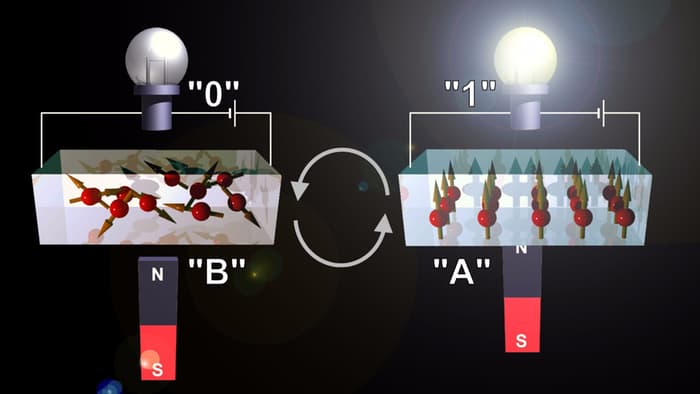Japanese scientists at Hokkaido University have developed a device that can switch safely between magnetic and electronic signals. By doing so, they’ve opened the door to a doubling of the storage capacity of conventional memory devices such as solid-state drives and USB flash drives.

Japanese researchers developed a storage material that can rapidly switch back and forth between magnetic and non-magnetic states. Image source: Hokkaido University.
In magnetic storage, data is represented in the direction of magnetization at various regions in a magnetic film, while conventional electronic storage devices store information in binary form within millions of small logic gates. The researchers theorized that it would be possible to add an A/B magnetic store for data to the existing 0/1 (electric) binary storage if a storage material could switch back and forth quickly between magnetic and non-magnetic states. Overall, this could double storage capacity.
As for compounds, transition metal oxides have the appropriate functional properties for this, since they switch between an insulating, non-magnet state to a high-conductivity metallic magnet state as they gain or lose oxide ions. But unfortunately, neither of the two standard methods for controlling oxygen off-stoichiometry (meaning without exact quantities in a lab) for their chosen compound, strontium cobalt oxide are feasible. One needs high-temperature heating, which can be dangerous to devices meant for room-temperature operation, and the other uses a liquid alkaline electrolyte that triggers an electrochemical reaction at room temperature, which leaks, so a device using this method couldn’t be sealed and miniaturized.
Instead, the researchers developed their own method. They traded the liquid alkaline for a sodium tantalate thin film, and laid it over the strontium cobalt oxide. Applying a three-amp current switched the device from its insulating form to its metal magnet form with two-to-three seconds. Reversing the current direction returned it to the insulating form.
Although the switching time is slow, it could be significantly hastened by shrinking the device, which would need to be done for commercial application.
According to the researchers, their approach could enable the development of new electromagnetic switching devices such as high-capacity flash storage, which could be used for your mobile phone, USB flash drive, or SSD, as well as new electro-optical and electro-thermal devices.
A paper describing the research was originally published in the journal, Advanced Electronic Materials .
Source: Hokkaido University
Advertisement
Learn more about Electronic Products Magazine





